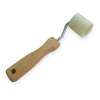mikemyers
Member
Considering that I've never, ever, even seen an RCBS Pro2000 in person, the more I think about it, the more I feel like setting it up exactly as per the RCBS instructions at first. I found a very straight-forward video on what I now plan to do (with one addition):
https://www.youtube.com/watch?v=wnfeTPZeOMQ
If I do it this way, station #4 is empty, just waiting for the lockout die.
I'm sure that those of you who know a lot more about this have found ways to improve the function, especially using the separate crimping die. I can always change in the future. For now, I just want to set the machine up "stock", and get used to using it.
(I also like the convenience of having the powder dispenser on the frame, so I can easily change die-plates when/if I want to, and that doing it this way makes it easier to pour out the powder at the end of each day.)
Doing it this way, while also using the lockout die, seems very simple.
Question - someone up above mentioned using some kind of "kitchen roller" to roll over the primers once they are pressed into the strips, to be sure they are all fully seated. Is this something most of you do, and if so, what kind of roller did you buy? If that really is a potential issue, this seems like a simple way to prevent it.
https://www.youtube.com/watch?v=wnfeTPZeOMQ
If I do it this way, station #4 is empty, just waiting for the lockout die.
I'm sure that those of you who know a lot more about this have found ways to improve the function, especially using the separate crimping die. I can always change in the future. For now, I just want to set the machine up "stock", and get used to using it.
(I also like the convenience of having the powder dispenser on the frame, so I can easily change die-plates when/if I want to, and that doing it this way makes it easier to pour out the powder at the end of each day.)
Doing it this way, while also using the lockout die, seems very simple.
Question - someone up above mentioned using some kind of "kitchen roller" to roll over the primers once they are pressed into the strips, to be sure they are all fully seated. Is this something most of you do, and if so, what kind of roller did you buy? If that really is a potential issue, this seems like a simple way to prevent it.







